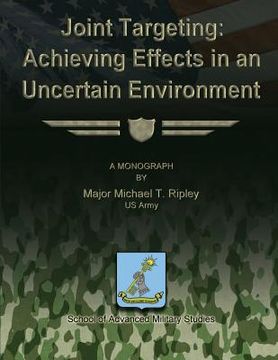Reseña del libro "Joint Targeting: Achieving Effects in an Uncertain Environment (en Inglés)"
The process of targeting the enemy and his elements of power is an essential component of achieving victory in modern warfare. Targeting is an intellectual military discipline that combines rigorous scientific analysis, a deep understanding of weapons effects, and sound operational judgment into a coherent systematic process. The Joint Targeting Process is the critical linkage in translating desired effects into the actions that accomplish objectives and achieve victory. It provides military commanders a methodology to systematically generate and refine a series of options to accomplish objectives and provides solutions to defined problems. The process attempts to evaluate the merits of possible solutions to a problem using an adaptable, effects-based approach to problem solving. The current Joint Targeting Process is highly effective in prosecuting traditional kinetic targets; however, it is questionable whether the process is fully capable of addressing non-lethal, non-kinetic, and indirect means of achieving the commander's desired effects. Current targeting doctrine evolved as an alternative to the notion of attrition warfare and grew with the evolution of technology. In a conventional, linear environment, the Joint Targeting Process optimizes the use of existing capabilities to accomplish military and political objectives. In an irregular, non-linear environment however, the Joint Targeting Process has difficulty identifying targets and matching appropriate capabilities to achieve desired effects. The Joint Targeting Process provides an iterative methodology for identifying and prioritizing enemy centers of gravity and then projecting power against them. This process became an airpower-dominated, destruction-based system that derived from an attrition-based ground warfare doctrine. The process uses an airpower-optimized approach to avoid protracted ground conflicts that result in an attrition-based or exhaustion-based solution to modern conflict. The methodology of the process focuses predominantly on kinetic combat operations against nation states possessing established infrastructure and fielded forces. The Joint Targeting Process is not fully effective in the emerging Joint Operational Environment where operations occur in ungoverned territory against non-state adversaries in an environment characterized by uncertainty, complexity, and ambiguity. This monograph undertakes a systematic approach to evaluating the effectiveness of the Joint Targeting Process within the context of the Joint Operational Environment. To address the question of how best to apply targeting to the current operating environment, this monograph examines the genesis of the current joint targeting methodology and discusses how our current joint doctrine developed, the evolution of targeting within traditional linear warfare doctrine, and the current application of military targeting. Additionally, it examines the emerging operational environment, characterizes the relevant operational context of targeting, and discusses how that context has changed since the development of targeting doctrine. This understanding of the evolution of targeting doctrine, coupled with an accurate assessment of how commanders and planners currently apply doctrine, provides observations on the current effectiveness of systematic targeting procedures. Finally, this monograph provides an analysis of joint targeting effectiveness in the Joint Operational Environment and provides recommendations for improving joint targeting doctrine. The last section will conclude this study with a summary of the previous topics discussed and some closing thoughts on future joint targeting.

